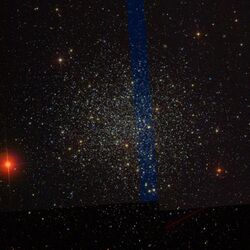Astronomy:NGC 5053
| NGC 5053 | |
|---|---|
 | |
| Observation data (J2000 epoch) | |
| Class | XI |
| Constellation | Coma Berenices |
| Right ascension | 13h 16m 27.09s[1] |
| Declination | +17° 42′ 00.9″[1] |
| Distance | 17.4 kpc (57 kly)[2] |
| Apparent magnitude (V) | 9.96[3] |
| Apparent dimensions (V) | 10.5' |
| Physical characteristics | |
| Tidal radius | 89.13 pc (290.7 ly)[2] |
| Metallicity | [math]\displaystyle{ \begin{smallmatrix}\left[\ce{Fe}/\ce{H}\right]\end{smallmatrix} }[/math] = −2.30[3] dex |
| Estimated age | 12.3±0.7 Gyr[4] |
| Other designations | Cr 267, C 1313+179, GCl 23 |
NGC 5053 is the New General Catalogue designation for a globular cluster in the northern constellation of Coma Berenices. It was discovered by German-British astronomer William Herschel on March 14, 1784 and cataloged as VI-7. In his abbreviated notation, he described it as, "an extremely faint cluster of extremely small stars with resolvable nebula 8 or 10′ diameter, verified by a power of 240, beyond doubt".[5] Danish-Irish astronomer John Louis Emil Dreyer reported in 1888 that the cluster appeared, "very faint, pretty large, irregular round shape, growing very gradually brighter at the middle".[6]
This is a metal-poor cluster, meaning the stars have a low abundance of elements other than hydrogen and helium—what astronomers term metallicity. As recently as 1995, it was considered the most metal-poor globular cluster in the Milky Way.[7] The chemical abundances of the stars in NGC 5053 are more similar to those in the dwarf galaxy Sagittarius Dwarf Spheroidal Galaxy than to the Milky Way halo. Along with the kinematics of the globular cluster, this suggests that NGC 5053 may have been stripped from the dwarf galaxy.[8]
There are ten known RR Lyrae variable stars in this cluster with masses ranging from 68% to 78% of the solar mass. Nine of these variables were reported by German astronomer Walter Baade in 1928, and the tenth by American astronomer Helen Sawyer in 1946.[9] The cluster hosts 27 known blue stragglers,[4] of which five are short period SX Phoenicis variable stars.[9]
NGC 5053 is a relatively low mass cluster with a low core concentration factor of 1.32. It sports a stream of tidal debris to the west with a projected length of 1.7 kpc. This stream may have been created through shock-induced processes.[10] The cluster is located less than 1° from Messier 53 and the two have nearly the same distance modulus, which corresponds to a spatial separation of around 2 kpc. There is a tidal bridge joining M53 to NGC 5053, suggesting the pair may have interacted in the past.[2] The cluster is following an orbit through the Milky Way that has a perigalacticon distance of 9 kpc and an orbital eccentricity of 0.84.[10] At present, it is 18.4 kpc from the Galactic Center, with a radial velocity of 42.0±1.4 km/s.[2]
References
- ↑ 1.0 1.1 Goldsbury, Ryan et al. (December 2010), "The ACS Survey of Galactic Globular Clusters. X. New Determinations of Centers for 65 Clusters", The Astronomical Journal 140 (6): 1830–1837, doi:10.1088/0004-6256/140/6/1830, Bibcode: 2010AJ....140.1830G.
- ↑ 2.0 2.1 2.2 2.3 Boberg, Owen M. et al. (May 2015), "Chemical Abundances in NGC 5053: A Very Metal-poor and Dynamically Complex Globular Cluster", The Astrophysical Journal 804 (2): 12, doi:10.1088/0004-637X/804/2/109, 109, Bibcode: 2015ApJ...804..109B.
- ↑ 3.0 3.1 Dalessandro, Emanuele et al. (November 2012), "Ultraviolet Properties of Galactic Globular Clusters with Galex. II. Integrated Colors", The Astronomical Journal 144 (5): 13, doi:10.1088/0004-6256/144/5/126, 126, Bibcode: 2012AJ....144..126D.
- ↑ 4.0 4.1 Arellano Ferro, A. et al. (February 2010), "CCD time-series photometry of the globular cluster NGC 5053: RR Lyrae, Blue Stragglers and SX Phoenicis stars revisited", Monthly Notices of the Royal Astronomical Society 402 (1): 226–244, doi:10.1111/j.1365-2966.2009.15931.x, Bibcode: 2010MNRAS.402..226A.
- ↑ Herschel, William (1786), "Catalogue of One Thousand New Nebulae and Clusters of Stars", Philosophical Transactions of the Royal Society of London 76: 457–499, doi:10.1098/rstl.1786.0027, Bibcode: 1786RSPT...76..457H, https://zenodo.org/record/1432282See p. 495.
- ↑ Dreyer, John L. E. (1971), "New General Catalogue of Nebulae and Clusters of Stars", Memoirs of the Royal Astronomical Society: 141, https://archive.org/details/NewGeneralCatalogueOfNebulaeAndClustersOfStarsIndexCatalogue, retrieved 2016-08-08.
- ↑ Sarajedini, Ata; Milone, Alejandra A. E. (January 1995), "BVI CCD photometry of NGC 5053: The most metal-poor galactic globular cluster", The Astronomical Journal 109 (1669): 269–279, doi:10.1086/117271, Bibcode: 1995AJ....109..269S.
- ↑ Sbordone, L. et al. (July 2015), "Chemical abundances of giant stars in NGC 5053 and NGC 5634, two globular clusters associated with the Sagittarius dwarf spheroidal galaxy?", Astronomy & Astrophysics 579: 12, doi:10.1051/0004-6361/201425509, A104, Bibcode: 2015A&A...579A.104S.
- ↑ 9.0 9.1 Nemec, James M. (April 2004), "Physical Characteristics of the RR Lyrae Stars in the Very Metal Poor Globular Cluster NGC 5053", The Astronomical Journal 127 (4): 2185–2209, doi:10.1086/382903, Bibcode: 2004AJ....127.2185N.
- ↑ 10.0 10.1 Lauchner, Adam et al. (November 2006), "Discovery of a Tidal Stream Extending from NGC 5053", The Astrophysical Journal 651 (1): L33–L36, doi:10.1086/509254, Bibcode: 2006ApJ...651L..33L.
External links
- Wide angle view with M53 Panagiotis Xipteras
 |

